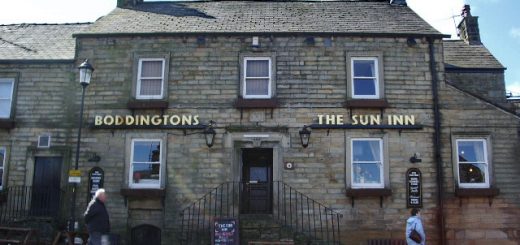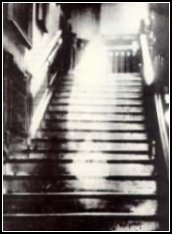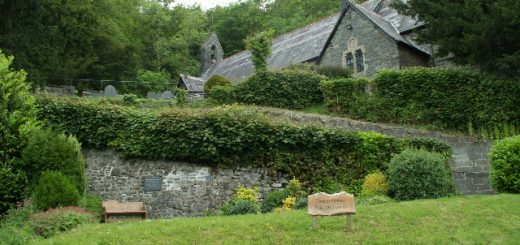The Old Black Dog, Uplyme
The Old Black Dog Inn has a curious story as to how it acquired its name. A local man who lived in a farm house that once formed part of a mansion destroyed in the civil war, found his house haunted by a black dog. The dog manifested by the hearth almost every night. Consider the article, The Lyme Regis Black Dog.
One night he came home drunk grabbed a poker and chased the dog into the attic, the dog disappeared through the roof, which he smashed through with the poker. To his amazement a hoard of golden coins from the civil war period spilled from the roof. He used these to buy and convert a house nearby into a pub which he called the Black Dog. The dog still haunts the lane by the pub and was seen in the 1950’s.
A Phantom coach driven by four horses has been seen on what was the old coaching road.




Re: The Old Black Dog, Uplyme
The Black Dog of Uplyme
by David Taylor
They say that everything comes to he who waits. Well, having waited 33 years, I finally visited the atmospheric green lane in Dorset allegedly haunted by a phantom black dog.
In 1980, Janet & Colin Bord published their classic ‘Alien Animals’ (Bord & Bord, 1980), a book on cryptozoology. This is where I first came across references to the phantom black dog of Uplyme, near Lyme Regis in Dorset. The small village of Uplyme lies on the main road between Axminster and Lyme Regis.
The legend of the black dog tells of a local man who was regularly haunted by a black dog. He got so fed up with the ghost that he chased it with a stick into the roof of his house. The dog vanished into the ceiling, and the man’s stick disturbed a pile of coins that fell out of the roof. The man used the coins to build the inn, calling it the Black Dog after the ghost.
It is said that the black dog haunts Haye Lane (previously called Dog Lane) at dusk. The dog is said to look quite normal in the distance, but as it gets nearer to you it becomes bigger and bigger and then suddenly disappears. It is said that some local people will not venture down this lane at night.
There are also warnings to dog owners not to let their dogs roam on their own at dusk in Haye Lane. It has been said that dogs who have run about on their own in Haye Lane have mysteriously disappeared in the past.
The legend was first published in 1866 by Larwood and Hotten in their ‘History of Signboards’ and was repeated in ‘Chambers’ Book of Days’ in 1888.
An early sighting of the phantom black dog occurred in 1856. Walking with her husband one night down the lane, she suddenly became aware of the dog walking close to her. It seemed to give off a cold, dank feel. The dog got bigger and bigger until it suddenly vanished. Her husband saw nothing.
When the folklorist Theo Brown visited the area in 1960, she was told of a sighting by a family of holiday makers in the Autumn of 1959. While walking down the lane they had all seen a black dog float in front of them and then vanish. They reportedly made a hasty retreat back to the safety of the pub. (Brown, 1982)
In September 2013 my wife Carolyn and I visited the spot of these supernatural occurances. The lane is deceptively short and forms part of the natural border separating Dorset and Devon. The folklorist Jeremy Harte has made a study of over 70 haunted roads in Dorset. He found that up to 54% of his cases occurred next to parish boundaries. These findings were higher than chance expectations (Harte, 1994).
Today (Sept 2013) the pub is long gone, the original building is now a Bed & Breakfast and tea room. When we visited it we managed to chat to the tea room owner. Despite a history of psychic experiences, she had not seen the phantom canine herself.
If you are planning a visit to Dorset, what better way to break up the journey than stopping off at the Old Black Dog tea room (www.oldblackdog.co.uk) for a spot of ghost hunting from the comfort of the tea room. The Apple cake is highly recommended!
REFERENCES:
BORD, Janet & Colin, 1980, Alien Animals, Granada
BROWN, Theo, 1982, Devon Ghosts, Jarrold & Sons
HARTE, Jeremy, 1994, ‘Haunted Roads’, The Ley Hunter, No. 121
Re: The Old Black Dog, Uplyme
English Fairy and Other Folk Tales by Edwin Sidney Hartland [1890]
Lyme-Regis, in Dorsetshire, has a famous story about one of these canine apparitions. About a mile from the town stands a farmhouse, which once formed part of an old mansion that was demolished in the parliamentary wars, except the small portion still existing. The sitting-room now used by the farmer, and also by his predecessors for a century or two, retains the large old-fashioned fireplace, with a fixed seat on each side under the capacious chimney. Many years ago, when the then master of the house, as his custom was after the daily toils were over, used to settle himself on one of these snug seats in the chimney corner, a large black dog as regularly took possession of the opposite one. This dog in all essentials resembled the spectre-dog already described. For many nights, weeks, and months this mysterious visitor, sitting vis-à-vis to the farmer, cast a gloom over his evening enjoyment. At length, as he received no harm from his companion, and became accustomed to his appearance, he began to look on him as one of the family circle. His neighbours, however, often advised him to drive away the fiend-like intruder; but the farmer, not relishing a contest with him, jestingly replied: "Why should I? He costs me nothing–he eats nothing, he drinks nothing, he interferes with no one. He is the quietest and frugalest creature in the house."
One night, however, the farmer, having been drinking too freely with a neighbour, and excited by his taunts about the black dog to an unusual degree of irritation, was determined his courage should no more be called in question. Returning home in a rage, he no sooner saw the dog on his usual seat, than, seizing the poker, he rushed with it towards his mysterious companion. The dog, perceiving his intention, sprang from its seat, and ran upstairs, followed by the infuriated farmer. The dog fled into an attic at the top of the house, and just as the farmer entered the same room, he saw it spring from the floor, and disappear through the ceiling. Enraged at being thus foiled, he struck with the poker the ceiling where the dog had passed through, and down fell a small old-fashioned box, which, on being opened, was found to contain a large sum in gold and silver coins of Charles I.’s reign. The dog was never more seen within doors, but to the present day continues at midnight to haunt a lane which leads to this house, and which has long borne the name of "Dog Lane," while a small inn by the roadside still invites the passing stranger by the ominous sign of "The Black Dog," portrayed in all his spectral frightfulness. So late as the year 1856, a respectable intelligent woman told the writer that she herself had seen the dog-ghost. "As I was returning to Lyme," said she, "one night with my husband down Dog Lane, as we reached about the middle of it, I saw an animal about the size of a dog meeting us. ‘What’s that?’ I said to my husband. ‘What?’ said he, ‘I see nothing.’ I was so frightened I could say no more then, for the animal was within two or three yards of us, and had become as large as a young calf, but had the appearance of a black shaggy dog with fiery eyes, just like the description I had heard of the ‘black dog.’ He passed close by me, and made the air cold and dank as he passed along. Though I was afraid to speak, I could not help turning round to look after him, and I saw him growing bigger and bigger as he went along, till he was as high as the trees by the roadside, and then seeming to swell into a large cloud, he vanished in the air. As soon as I could speak, I asked my husband to look at his watch, and it was then five minutes past twelve. My husband said he saw nothing but a vapour or fog coming up from the sea." A case of this kind shows how even a sensible person may become the victim of self-delusion; for in all practical matters this woman was remarkably sober-minded, intelligent, and ludicious; and well educated for a person of her calling–that of sick-nurse, the duties of which she discharged in the writer’s house for several weeks to his fullest satisfaction, showing no symptoms of nervousness or timidity.